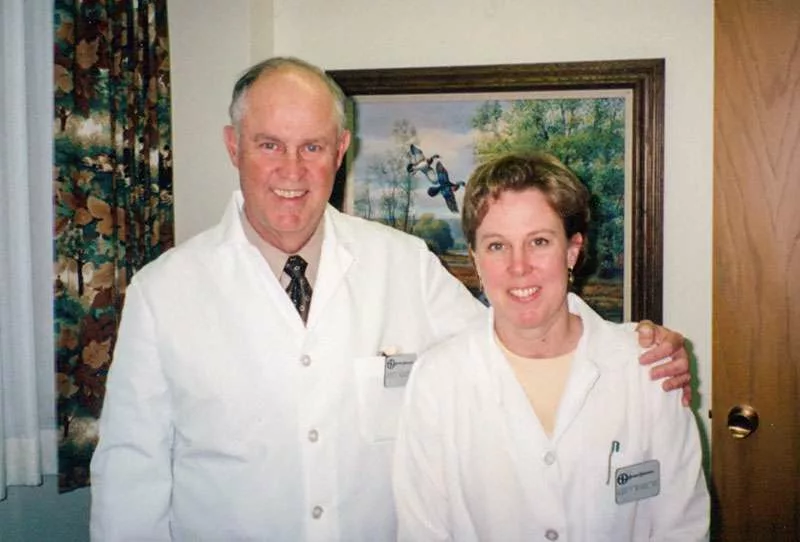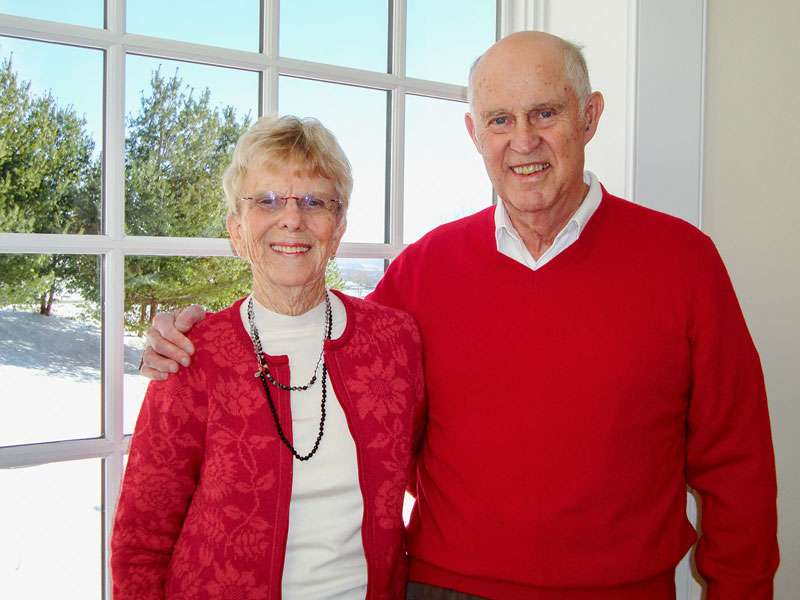As a young family physician who had recently returned from serving as a U.S. Air Force flight surgeon, David Morris, MD ’54, began his civilian career in a private practice in the southwestern Wisconsin town of West Salem.

He often encountered patients with agriculture-related respiratory allergies, which would progress into wheezing and incapacitating fatigue. Realizing the discomfort and inconvenience the illnesses caused for rural patients — at times of the year when farmers are busier than ever — piqued his interest in conducting allergy-related research.
Sublingual Immunotherapy Treatment Explored
He learned of a treatment, more common in Europe than the United States, that entailed delivering minuscule amounts of antigens via drops under the tongue, the site of the body’s largest collection of dendritic cells, which are important messengers in the immune system. This technique, he posited, would stimulate the cells, causing them to down-regulate a patient’s allergy through the cervical lymph nodes. He believed that by working with the body’s natural immune system, patients would build a tolerance to the antigens. If successful, David Morris hoped, he could eliminate his patients’ debilitating symptoms.
By 1960, board certified in family practice (and later by the American Board of Allergy and Immunology), David Morris began to explore similar therapies for allergies to triggers like dust mites, molds and foods. A decade after his first successful treatment, he and his medical partners founded Allergy Associates of La Crosse, Wisconsin, where he had moved with his wife, Sacia Morris, and their growing family.

There, the medical partners trademarked the La Crosse Method Protocol™, a sublingual immunotherapy treatment designed to help patients build tolerance to a growing list of environmental and food allergies. They and others they have trained have since treated nearly 200,000 patients, published their findings in peer-reviewed journals and presented their work at national conferences. When the World Health Organization endorsed sublingual immunotherapy as a viable alternative to injection therapy in 1998, David Morris and his partners established a complementary educational company, Allergychoices, Inc.™ The company keeps U.S. physicians and patients abreast of the latest science behind the protocol; provides training and patient education; and supports treatment through licensed pharmacy, testing and support services across the United States, enabling patients to get consistent care close to home.
Yet, while some professional groups — such as the world health initiative on allergic rhinitis, called the Allergic Rhinitis and Its Impact on Asthma — endorse sublingual therapy, the majority of mainstream allergists have yet to embrace the treatment. Many argue that research investigations have not fully proven its efficacy. And many consider that a few outstanding questions, related to optimal dose and the efficacy of multiallergen sublingual immunotherapy, remain.
Passing the Torch
Through the years, David Morris repeated to colleagues, “What matters is that the patients get better.” When he died in early 2017, David Morris left a thriving practice of devoted colleagues, including his daughter, Mary Morris, MD ’83. The second of David and Sacia Morris’ four children, Mary Morris spent Saturdays and summers helping at the clinic during her teen years. After completing her internal medicine residency at Mount Sinai Medical Center in the University of Wisconsin School of Medicine and Public Health (SMPH) Milwaukee Academic Campus, she practiced at St. Luke’s Hospital in Milwaukee for two years before joining David Morris’ practice in 1989.

In La Crosse, Mary Morris and her husband, Jim Killoran, raised three daughters next door to her parents, and she pursued her research interests related to the therapy. Mary Morris says carrying on her father’s undertaking is bittersweet. Like her father, she finds reward in the appreciative patients who benefit from the treatment. Marveling at her father’s fortitude, she equally admires her mother, who buttressed her husband when people dismissed his theory. Mary Morris recalls, “I used to ask my dad, ‘How did you get so brave? How could you be shunned and still stand up?” She promptly responds — in a low-pitched voice to mimic her father’s likely reply, “Patients are getting better, honey! That’s what matters.”
In recent years, Douglas DeBoer, DVM, professor of dermatology at the UW School of Veterinary Medicine, working in partnership with Mary Morris, found sublingual immunotherapy effective in combating allergic reactions in dogs. It is now the standard of care in the veterinary world, Mary Morris says, noting the drops allow pet owners to administer the treatment at home and save a significant amount of money.
Establishing the Institute for Respiratory Research
Representing another legacy of David Morris’ passion — built through a sizable gift he and Sacia Morris made to his medical school alma mater, the UW School of Medicine and Public Health, in 2000 — the school established the Morris Institute for Respiratory Research in the Clinical Science Center. Designed to facilitate interdisciplinary research, the 10,000-square-foot facility brings together basic scientists and clinical experts in allergy, immunology, pulmonary medicine and more.
“My dad knew that people walking past one another in the hall to get a cup of coffee would be more likely to strike up conversations and share information for a larger cause,” Mary Morris says, as she describes David Morris’ vision for the institute. “That was, perhaps, his biggest legacy. By creating a vision for a physical space, he influenced interactions among clinicians, academicians and researchers.”
A Quarterly article in fall 2000 noted that David Morris considered the SMPH (then UW Medical School) a member of his extended family. It also noted that David Morris saw the gift as a way to further immunotherapy research and honor the memory of one of his former mentors, the legendary Dean William S. Middleton, MD. Morris was the president of the last class Middleton saw through all four years of medical school, and he remembered Middleton fondly as an involved, hands-on administrator.

At the time of the gift, David Morris said, “My wife and I have always given a significant portion of our earnings charitably. I thought it was time to do something for the medical school, to honor the caliber of the research.” Through the Morris Institute, the family’s legacy continues to grow. David and Sacia Morris’ gift has had “a remarkable, positive multiplier effect” in terms of securing major federal funding, describes SMPH Dean Robert Golden, MD. Today, the Morris Institute is home to cutting-edge research investigations that foster partnerships with colleagues locally, nationally and internationally.
Among these studies is the Urban Environment and Childhood Asthma (URECA) study, for which James Gern, MD, an SMPH professor of medicine and pediatrics, is the principal investigator. URECA is a multi-site study funded by the National Institutes of Health’s National Institute for Allergy and Infectious Diseases, as part of its Inner-City Asthma Consortium (see page 24). Gern, Nizar Jarjour, MD (PG ’89), and Robert Lemanske, Jr., MD ’75, are among several physician-researchers who conduct ground-breaking research in the Morris Institute.
Jarjour serves as its director and is a professor in the SMPH Department of Medicine and head of that department’s Division of Allergy, Pulmonary and Critical Care Medicine. Their asthma research, and that of colleagues, was featured in Quarterly magazine, Vol. 18, Number 3. UW–Madison is ranked number 1 among all public institutions in the United States and number 4 among all institutions for asthma research, according to the research analytics firm Expertscape (www.expertscape.com).
“The Morris Institute established an infrastructure that has enabled creative interactions among clinician-scientists and facilitated the growth and development of multi-talented, interdisciplinary research teams. These teams have contributed significantly to a more comprehensive understanding of the pathogenesis of respiratory diseases and to safe and effective treatment approaches to them,” says Lemanske, a professor in the SMPH Departments of Pediatrics and Medicine, associate dean for clinical and translational research and deputy executive director of the UW–Madison Institute for Clinical and Translational Research.
Jarjour concludes, “We greatly appreciate having such a wonderful facility where physicians, scientists and research coordinators work closely together to conduct cutting-edge research that is contributing to improved understanding and treatment of allergic and respiratory diseases.”